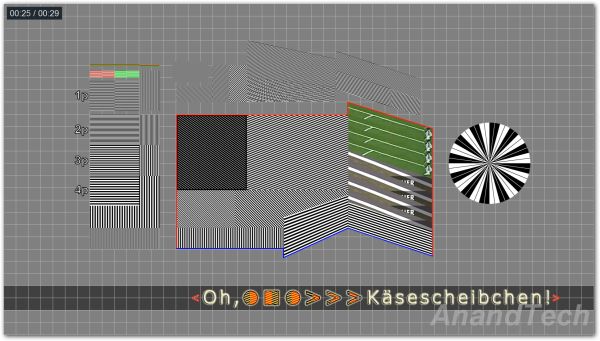Discrete HTPC GPU Shootout
by Ganesh T S on June 12, 2011 10:30 PM EST
Mismatches in the display refresh rate and source frame rate are difficult to spot for the average HTPC user, particularly if the dropped or repeated frames are far apart. Bad deinterlacing performance, on the other hand, may easily ruin the HTPC experience even for the average user. From DVDs to recorded TV shows and even Blu-ray documentaries, interlaced content is quite common.
We have been using the Cheese Slices test to check up on deinterlacing performance in the past. Instead of just covering the cheese slice alone, we will present a set of four consecutive deinterlaced frames from the video for you to judge.
Before presenting the results, let us take a look at how the ideal deinterlacing output should look like (a screenshot from the progressive version of the Cheese Slices clip around the same timestamp)
Click for Lossless Version
NVIDIA GT 430 Cheese Slices Deinterlacing:
MSI GT 520 Cheese Slices Deinterlacing:
AMD 6450 Cheese Slices Deinterlacing:
MSI 6450 Cheese Slices Deinterlacing:
Sapphire 6570 Cheese Slices Deinterlacing:
The Cheese Slices test is an artificial test clip. To bring some real world perspective to the deinterlacing performance, let us take a look at some screenshots of the 'Ship' clip from the Spears and Munsil High Definition Benchmark Test Disc (hereon referred to as the S&M clip). It is supposed to test the edge adaptive deinterlacing capabilities of the GPU. Note the jaggies in the various ropes in the screenshot. Roll the mouse over the various GPUs in the list below the image to see how each candidate performs.

| MSI GT 520 | MSI 6450 | NVIDIA GT 430 | Sapphire 6570 |
Pay particular attention to the deinterlacing performance of the GT 520. Compared to the other 4 cards in the test, this one emerges as the worst of the lot in the Cheese Slices test as well as the real world video test. When this was brought to NVIDIA's attention, they indicated the lack of shaders on the GF119 as the main reason for this issue. It looks like driver updates are not going to solve the issue in the future either. This is a big letdown for the prospective customers of the GT 520. Even though the deinterlacing performance of the GT 430 looks pretty good, a closer look reveals that it is not as effective as AMD's vector adaptive deinterlacing strategy.
On the AMD side, it looks like the reduced core clock frequency and lessened DRAM bandwidth of the MSI 6450 doesn't affect the deinterlacing performance in the Cheese Slices test. Vector adaptive deinterlacing works across all the cards in the 6xxx lineup. However, AMD has admitted to some driver issues for local file playback in the DDR3 based 6450s. This is probably the reason for the bad performance of the MSI 6450 in the S&M ship clip above. In an informal blind test, a majority seemed to prefer the 6570's output in the clip above, but you can decide for yourself.
The Catalyst Control Center allows users to experiment with different deinterlacing algorithms, while NVIDIA's Control Center doesn't. Admittedly, this choice of deinterlacing algorithms is of academic interest only. That said, the bad deinterlacing performance of the GT 520 and the fact that it is not going to improve in the future forces us to declare AMD the winner in this area.































70 Comments
View All Comments
enki - Monday, June 13, 2011 - link
How about a short conclusion section for those who just use a Windows 7 box with a Ceton tuner card to watch hdtv in Windows Media Center? (i.e. will just be playing back WTV files recorded directly on the box)What provides the best quality output?
What can stream better then stereo over HDMI? On my old 3400 ATI card it either streams the Dolby Digital directly (the computer doesn't do any processing of the audio) or can output stereo (doesn't think there can be more then 2 speakers connected)
Thanks
BernardP - Monday, June 13, 2011 - link
The inability to create and scale custom resolutions within AMD graphics drivers is, for me, a deal-breaker that keeps me from even considering AMD graphics. It will also keep me from Llano, Trinity and future AMD Fusion APU's. I'll stay with NVidia as long as they keep allowing for custom resolutions.My older eyes are grateful for the custom 1536 X 960 desktop resolution on my 24 inch 16:10 monitor. I couldn't create this resolution with AMD graphics drivers.
bobbozzo - Tuesday, June 14, 2011 - link
In your case, you should just increase the size of the fonts and widgets instead of lowering the screen res.Assimilator87 - Tuesday, June 14, 2011 - link
I wish there was a section dedicated to the silent stream bug. I have a GTX 470 hooked up to an Onkyo TX-SR805 and this issue is driving me insane. For instance, does this issue only plague certain cards or do all nVidia suffer from it? I was hoping the latest WHQL driver (275.33) would fix this, but sadly, no. Otherwise, the article was amazing and I'll definitely have to check out LAV Splitter.ganeshts - Tuesday, June 14, 2011 - link
The problem with the silent stream bug is that one driver version has it, the next one doesn't and then the next release brings it back. It is hard to pinpoint where the issue is.Amongst our candidates, even with the same driver release, the GT 520 had the bug, but the GT 430 didn't. I am quite confident that the GT 520 issue will get resolved in a future update, but then, I can just hope that it doesn't break the GT 430.
JoeHH - Tuesday, June 14, 2011 - link
This is simply one of the best articles I have ever seen about HTPC. Congrats Ganesh and thank you. Very informative and useful.bobbozzo - Tuesday, June 14, 2011 - link
Hi, Can you please compare hardware de-intelacing, etc., vs software?e.g. many players/codecs can do de-interlacing, de-noise, etc. in software, using the CPU.
How does this compare with a hardware implementation?
thanks
ganeshts - Tuesday, June 14, 2011 - link
This is a good suggestion. Let me try that out in the next HTPC / GPU piece.CiNcH - Wednesday, June 15, 2011 - link
Hey guys,here is how I understand the refresh rate issue. It does not matter weather it is 0.005 Hz off. You can't calculate frame drops/repeats from that. In DirectShow, frames are scheduled with the graph reference clock. So the real problem is how much the clock which the VSync is based on and the reference clock in the DirectShow graph drift from each other. And here comes ReClock into play. It derives the DirectShow graph clock from the VSync, i.e. synchronizes the two. So it does not matter weather your VSync is off as long as playback speed is adjusted accordingly. A problem here is synchronizing audio which is not too easy if you bitstream it...
NikosD - Thursday, June 16, 2011 - link
Nice guide but you missed something.It's called PotPlayer, it's free and has built-in almost everything.
CPU & DXVA (partial, full) codecs and splitters for almost every container and every video file out there.
The same is true for audio, too.
It has even Pass through (S/PDIF, HDMI) for AC3/TrueHD/DTS, DTS-HD. Only EAC3 is not working.
It has also support for madVR and a unique DXVA-renderless mode which combines DXVA & madVR!
I think it's close to perfect!
BTW, in the article says that there is no free audio decoder for DTS, DTS-HD.
That's not correct.
FFDShow is capable of decoding and pass through (S/PDIF, HDMI) both DTS and DTS-HD.
And PotPlayer of course!